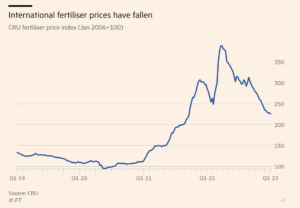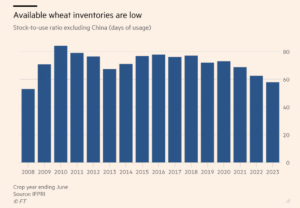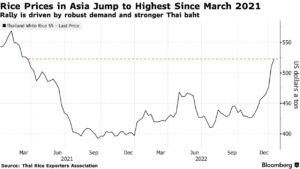U.S. President Donald Trump said on Monday that farming equipment has gotten too expensive and his administration would help tractor companies by removing some environmental rules that affect them.
FT: “World’s Food Supplies Still Under Threat,” “Multiple Risks Remain,” Notes Bloomberg News
Emiko Terazono reported on Saturday at The Financial Times Online that, “Fertiliser and crop prices have fallen sharply since their peaks after last year’s Russian attack on Ukraine.
Yet agriculture specialists and analysts have warned that the world’s food supplies are still under threat.
“Food prices were already elevated before Russia’s full-scale invasion of Ukraine early last year, due to droughts and coronavirus pandemic-related hoarding by governments and businesses.

“Then crop nutrient prices soared as a result of Moscow’s position as the world’s largest fertiliser exporter, while the jump in natural gas prices, a critical ingredient for nitrogen fertilisers, also piled pressure onto agricultural markets.
“Last year’s Black Sea grain deal between Moscow and Kyiv played a crucial role in subduing prices, along with plentiful supplies from Russia, while lower natural gas prices have calmed fertiliser markets.

“However, analysts warn the grain deal could unravel, while volatile energy prices and climate change also threaten to undermine crop production.”
The FT article noted that, “‘It’s like flying with one engine,’ said John Baffes, senior agricultural economist at the World Bank. ‘As long as that engine works it’s fine, but if the engine stops then you have problems . . . If any of [these risks] materialise, we’ll see a [rise in prices] very, very quickly.'”

Terazono explained that, “The most immediate danger is the UN-backed grain deal, which is due to be renewed in March. Any failure to extend it would block exports of Ukrainian grain, sending prices rocketing again.”
The FT article added that, “A record wheat crop in Russia and bumper corn and soyabean harvests in Brazil have relieved tightness in international grain and vegetable oil markets, while a recent fall in the price of natural gas, a feedstock, has increased production of nitrogen crop nutrients.”
“‘We are very much at an inflection point. The input [costs] and the margin pressure for the farmer appears to be easing substantially,’ said Michael Magdovitz, grains and oilseeds analyst at Rabobank.”
And on Friday, Bloomberg writer Agnieszka de Sousa reported that, “After last year’s rampant food inflation, a drop in prices of goods from wheat to fertilizers is raising hopes for some respite in 2023.
But multiple risks remain.
The Bloomberg article stated that, “Agri-commodities and fertilizers are still historically expensive, while grain stockpiles remain tight just as extreme weather in places like Argentina and East Africa damages crop prospects, according to economists Rob Vos, Joseph Glauber and David Laborde.
“High costs are also hurting farm profits. It all points to a reduced outlook for foodstuffs, even if the Black Sea crop-export deal remains in place, they said.”
The Bloomberg article indicated that, “Soaring rice prices are one example of persistent food inflation. And earlier this week, the US envoy to United Nations agencies in Rome said that the worst food crisis since World War II will only end if Russia pulls out of Ukraine.

“‘The fact that the food prices are going down does not mean this crisis is anywhere near being over,’ ambassador Cindy McCain said in an interview. ‘We’re looking at some difficult times.'”





